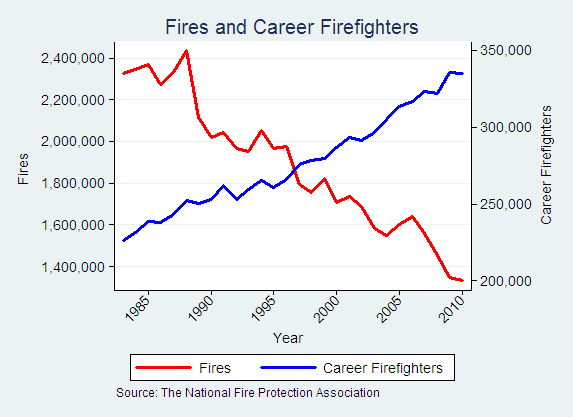Firefighters Don’t Fight Fires
Over the past 35 years, the number of fires in the United States has fallen by more than 40% while the number of career firefighters has increased by more than 40% (data).
(N.B. Volunteer firefighters were mostly pushed out of the big cities in the late 19th century but there are a surprising number who remain in rural areas and small towns; in fact, more in total than career firefighters. The number of volunteers has been roughly constant and almost all of them operate within small towns of less than 25,000. Thus, you can take the above as approximating towns and cities of more than 25,000.)
The decline of demand has created a problem for firefighters. What Fred McChesney wrote some 10 years ago is even more true today:
Taxpayers are unlikely to support budget increases for fire departments if they see firemen lolling about the firehouse. So cities have created new, highly visible jobs for their firemen. The Wall Street Journal reported recently, “In Los Angeles, Chicago and Miami, for example, 90% of the emergency calls to firehouses are to accompany ambulances to the scene of auto accidents and other medical emergencies. Elsewhere, to keep their employees busy, fire departments have expanded into neighborhood beautification, gang intervention, substitute-teaching and other downtime pursuits.” In the Illinois township where I live, the fire department drives its trucks to accompany all medical emergency vehicles, then directs traffic around the ambulance—a task which, however valuable, seemingly does not require a hook-and-ladder.
Here’s some data. Note that medical calls dwarf fire calls. Twenty five years ago false alarms were half the number of fires, today false alarms significantly exceed the number of fires.
According to Nightline it costs $3,500 every time a fire truck pulls out of a fire station in Washington, DC (25 calls in a 24 hour shift is not uncommon so this adds up quickly). Moreover, most of the time the call is not for a fire but for a minor medical problem. In many cities, both fire trucks and ambulances respond to the same calls. The paramedics do a great job but it is hard to believe that this is an efficient way to deliver medical care and transportation. A few locales have experimented with more rational systems. For example:
For calls that are not a life or death, Eastside Fire and Rescue stations [in WA state] will no longer send out a fire truck but instead an SUV with one certified medic firefighter.
Sounds obvious, but it’s hard to negotiate with heroes especially when they are unionized with strong featherbedding contracts.

